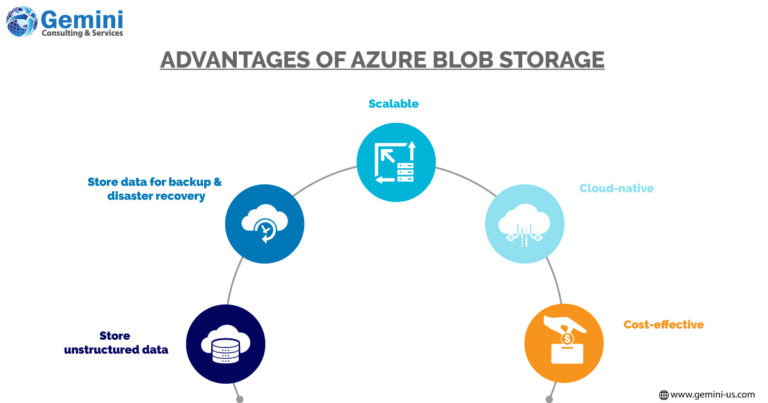Different businesses have unique requirements for data storage, which hinge on factors such as data characteristics and utilization methods. Microsoft Azure Storage caters precisely to these diverse user needs, offering cloud-based data storage solutions that also grant the flexibility to transition to alternative storage options if necessary.
Two prominent offerings within Microsoft Azure Storage, Blob Storage and File Storage, are tailored to the specific nature of the data being managed. A fundamental step in developing a comprehensive data storage strategy involves recognizing the significance of both structured and unstructured data.
Structured business data is methodically arranged into predetermined formats that align with the operational demands of the business. This well-defined formatting facilitates easy comprehension and targeted utilization by typical business users. It neatly fits into predefined fields like tables, records, or files, with a notable example being data found in Excel spreadsheets.
Conversely, unstructured data takes the form of an amalgamation of diverse data formats stored within data lakes. This collection encompasses a wide spectrum, spanning from social media posts and videos to text files. An inherent advantage of unstructured data lies in its capacity to furnish qualitative insights, thereby assisting stakeholders in discerning trends and shifts.
The main difference between both types of data is that unstructured data uses a schema-on-read data analysis strategy. As a result, data gets organized as it gets pulled out of the storage than when it is entered. Relational databases house structured data, while NoSQL databases contain unstructured data. Businesses combine both types of data to extract the maximum insights on business intelligence.
However, effectively harnessing structured and unstructured data demands specialized skills, appropriate tools, and a profound grasp of how to extract value from this wealth of information.

Microsoft Azure Blob and File Storage
Cloud-based Azure Blob Storage solution from Microsoft enables users to store and manage large amounts of unstructured data. These unstructured data include audio, video, and text files. It operates using a schema-on-read data analysis strategy, meaning data is organized as it’s pulled out of storage rather than when it’s initially entered. This makes it suitable for storing media, backups, data logs, and building data lakes for various applications. Access to Blob Storage data can be achieved through Azure Storage REST API, Azure CLI, Azure PowerShell, or Azure Storage client libraries in languages like .NET, Node.js, Java, Python, PHP, Ruby, and Go.
On the other hand, Azure File Storage offers file shares that can be mounted on compatible operating systems like Windows, Linux, and MacOS using protocols like SMB or NFS. It provides a file server-like experience and is useful for migrating on-premise applications to the cloud, allowing access to files from multiple virtual machines. Azure File Storage also supports REST API access through FileREST API, allowing files to be accessed via HTTP/HTTPS URLs with Shared Access Signatures (SAS) tokens, granting specific access for a limited time.
Azure Blob Storage is optimized for handling unstructured data and is beneficial for storing media and data logs, while Azure File Storage provides file shares that can be accessed from various operating systems and is suitable for migrating on-premise applications and sharing files across virtual machines.
Overview of Data Storage
Azure Blob Storage serves as a repository for objects, housing unstructured data within a flat namespace. Objects are stored in a key-value structure, where the key signifies the object’s name, and the value encapsulates the actual data. This arrangement can be likened to metadata, structured into distinct components.
The process involves setting up a storage account followed by Blob creation. Within Blob storage, numerous containers can exist, each containing distinct Blob Objects. These Blob Objects come in different forms: Page Blobs for virtual hard drives, Block Blobs for binary or textual data, and Append Blobs for unedited logs.
For instance, consider a developer requiring access to an IDE without internet downloads. If the organization stores the tool and shares access links with the development team, Azure Blob Storage becomes a convenient solution.
Blob Storage is best to:
- Share videos, documents, or images directly using a browser.
- Store video/audio files, storing and updating log files.
- Data storage for backup/restore, archiving, and disaster recovery.
- Leverage IoT and store data for analysis.

Azure File Storage, on the other hand, emulates a conventional Windows file system. It differs in that it’s remotely mounted and boasts limitless storage capacity. Both virtual and local machines can be employed to mount Azure file systems, with multiple shares accessible simultaneously through distinct machines.
The key distinction between these storage services lies in their functionality. Azure Blob Storage excels at managing substantial amounts of unstructured data cost-effectively, whereas Azure File Storage is tailored for seamless migration activities.
Gemini Consulting & Services can help your enterprise take advantage of the features offered by Azure Blob Storage and Azure File Storage to enhance collaboration and productivity. Contact us to delve deeper into selecting the optimal storage solution for your business.
Use Cases
Azure Blob Storage suits scenarios involving data streaming and random access from varied locations, such as data lakes and big data analytics. It’s ideal for document delivery to browsers, log writing, media file streaming, data storage for future analysis, disaster recovery, and archiving. This service offers cost-efficient, easily accessible tiered storage, making it an optimal offsite backup repository.
For businesses reliant on file-based APIs, Azure File Storage facilitates a smooth transition. Applications can be migrated from on-premises to Azure, eliminating the need for provisioning file server VMs. Cloud apps harmoniously interact with on-premises counterparts, maintaining consistency. This integration supports modern app development, amalgamates legacy programs with contemporary cloud services, or fosters new file-based applications.
In summary, Azure Blob Storage is designed to manage vast quantities of unstructured data, while Azure File Storage acts as a fully managed file system based on the SMB protocol, behaving akin to a standard hard drive.



